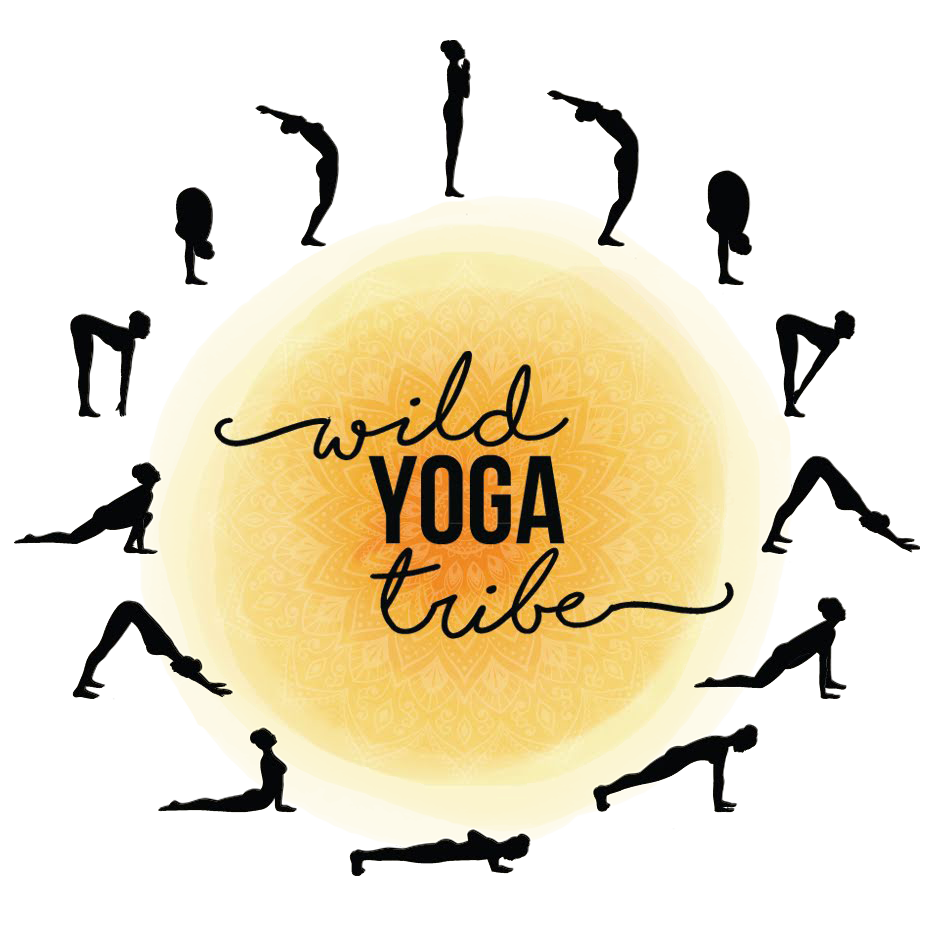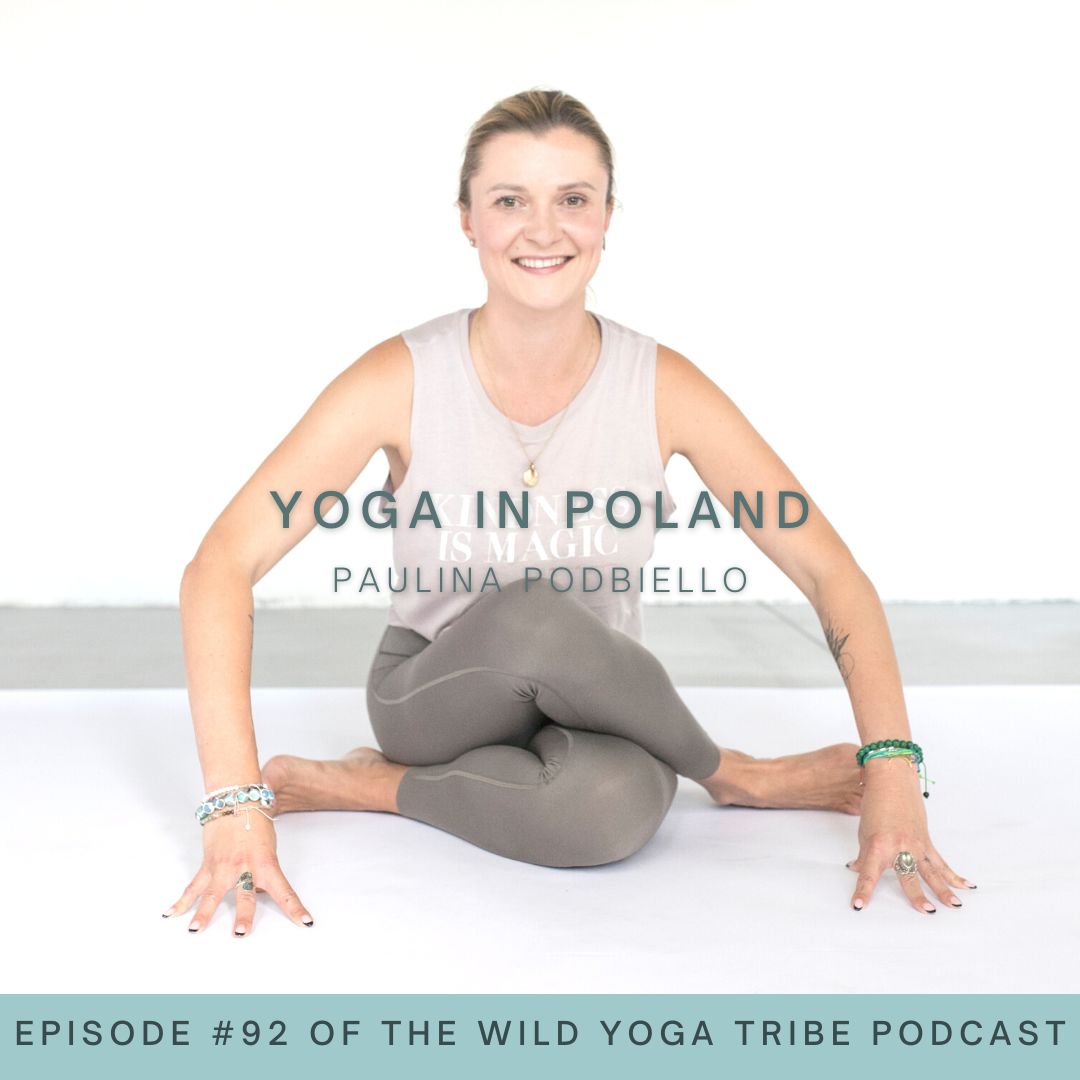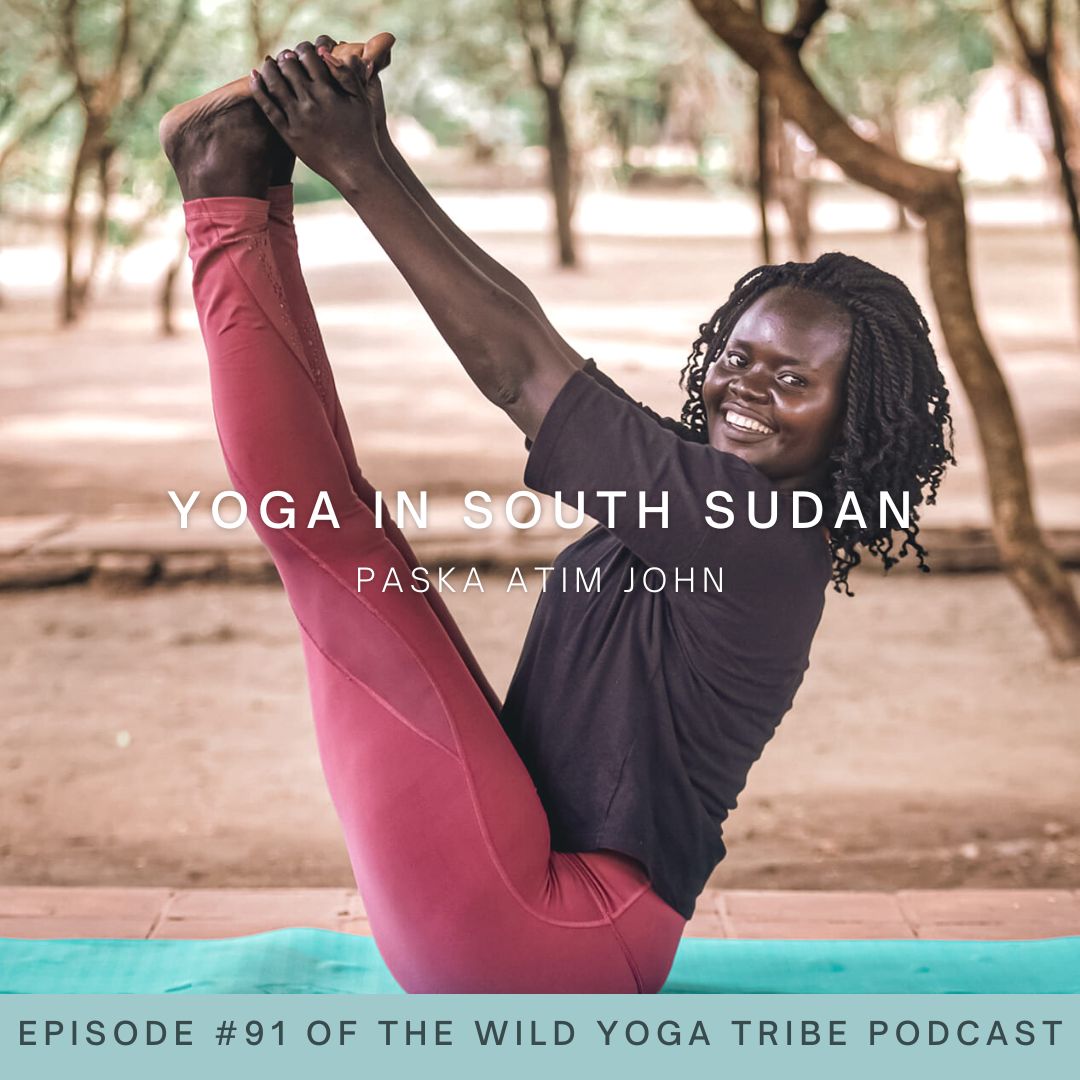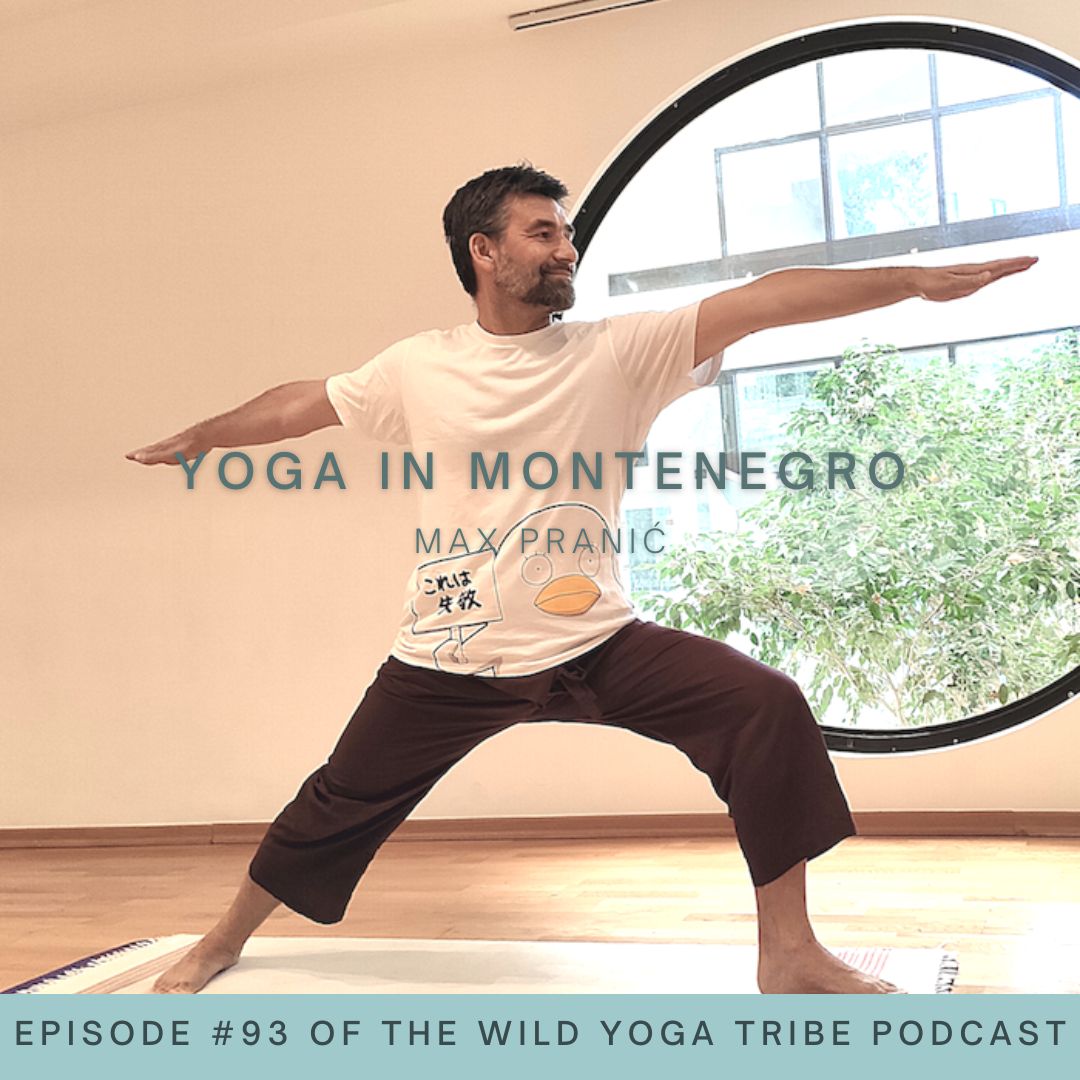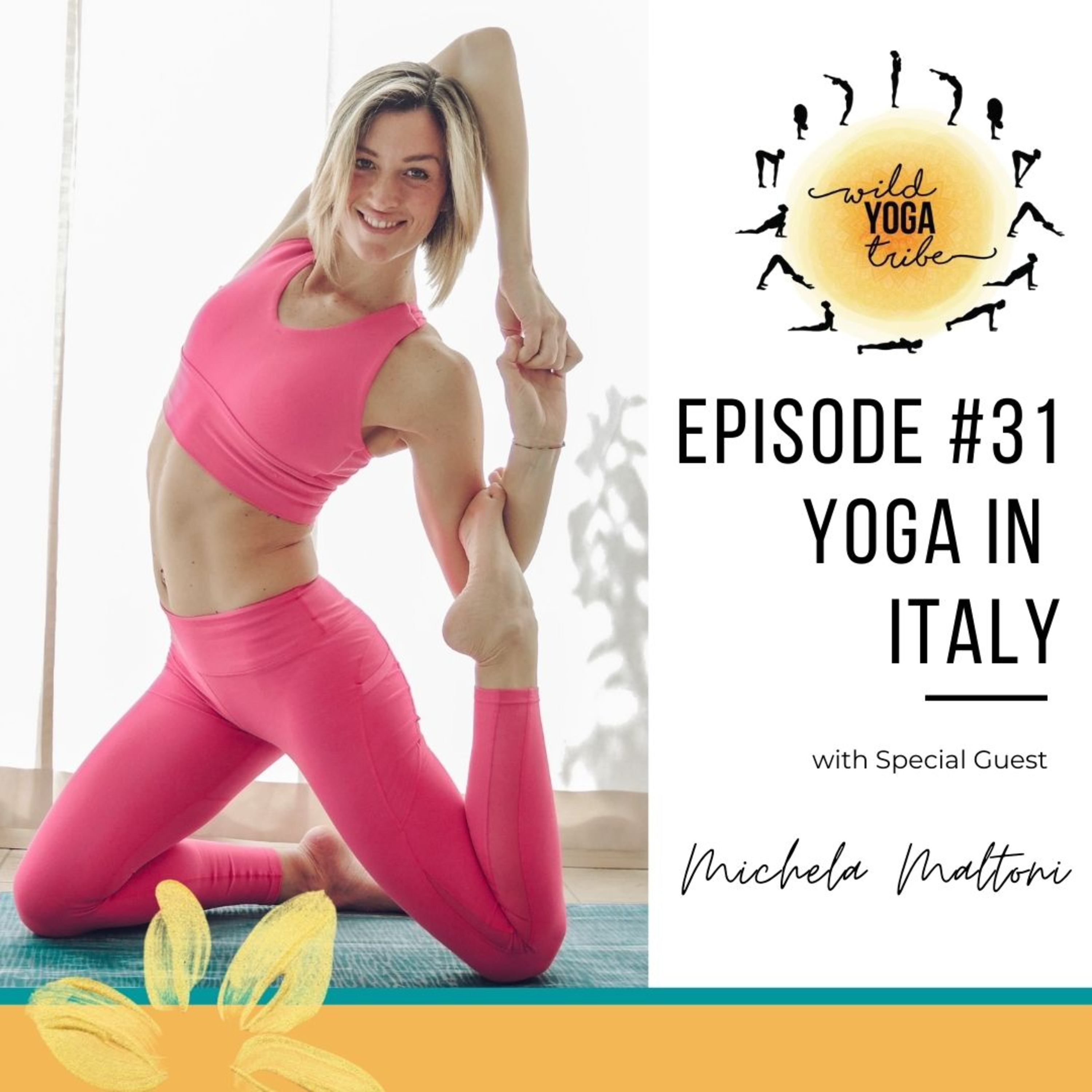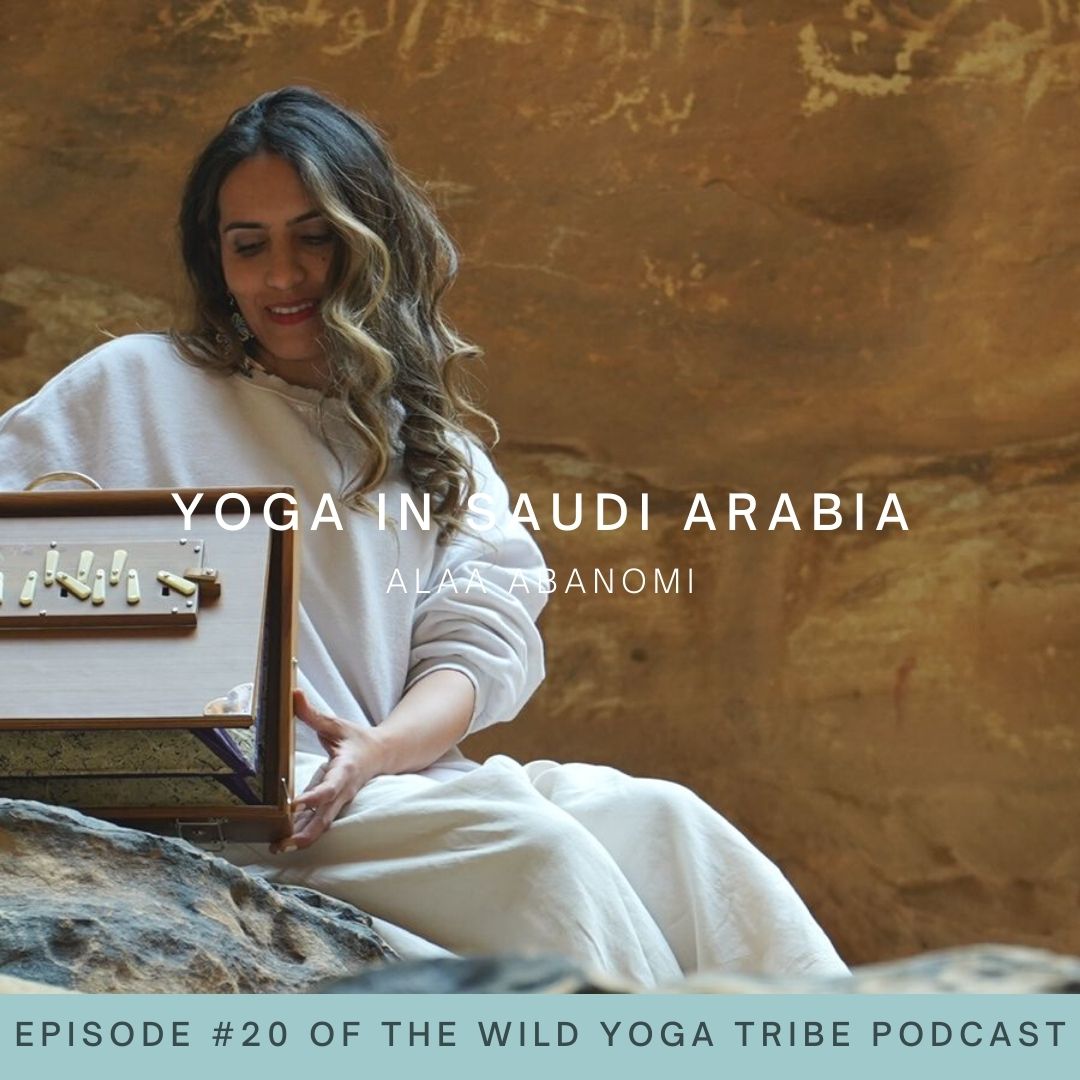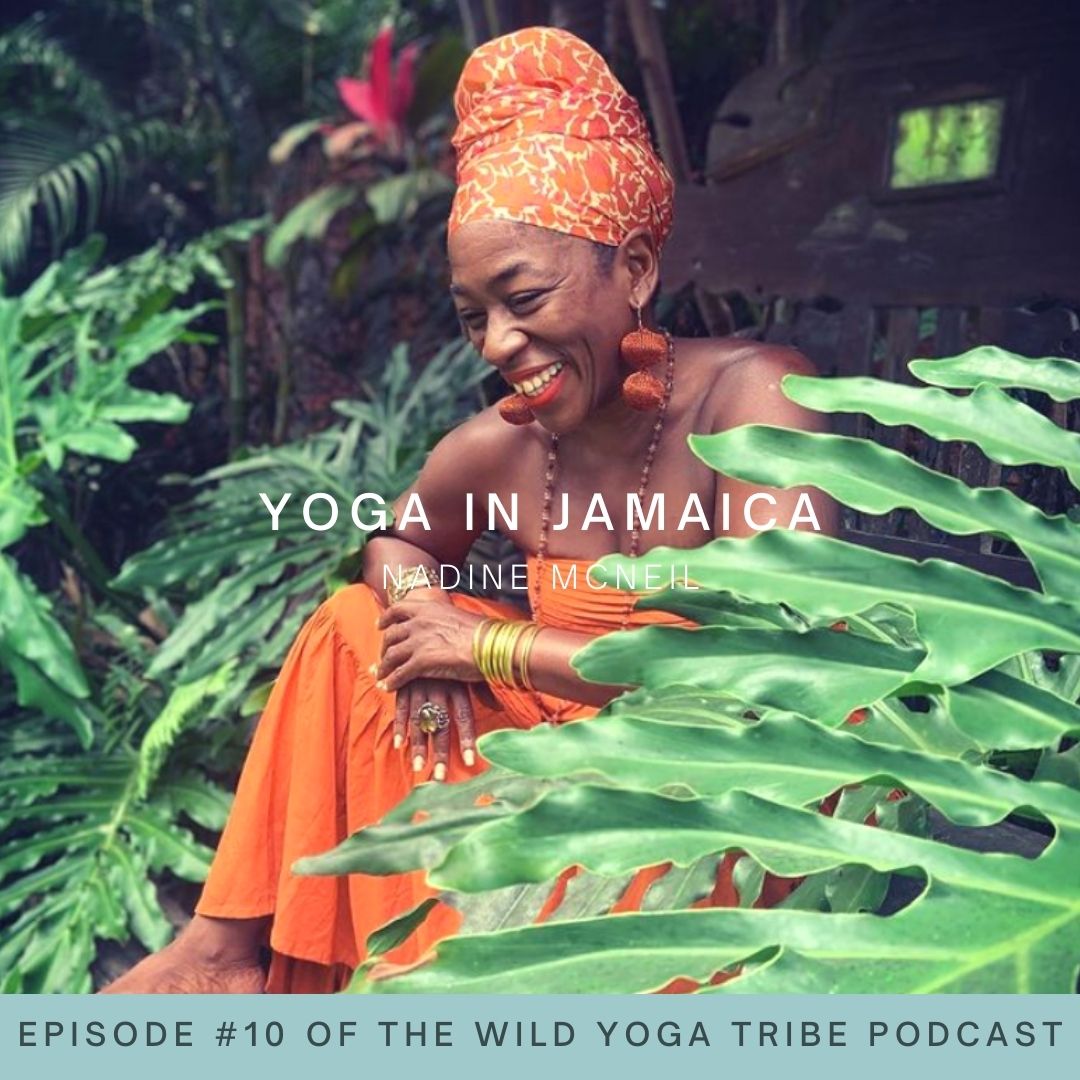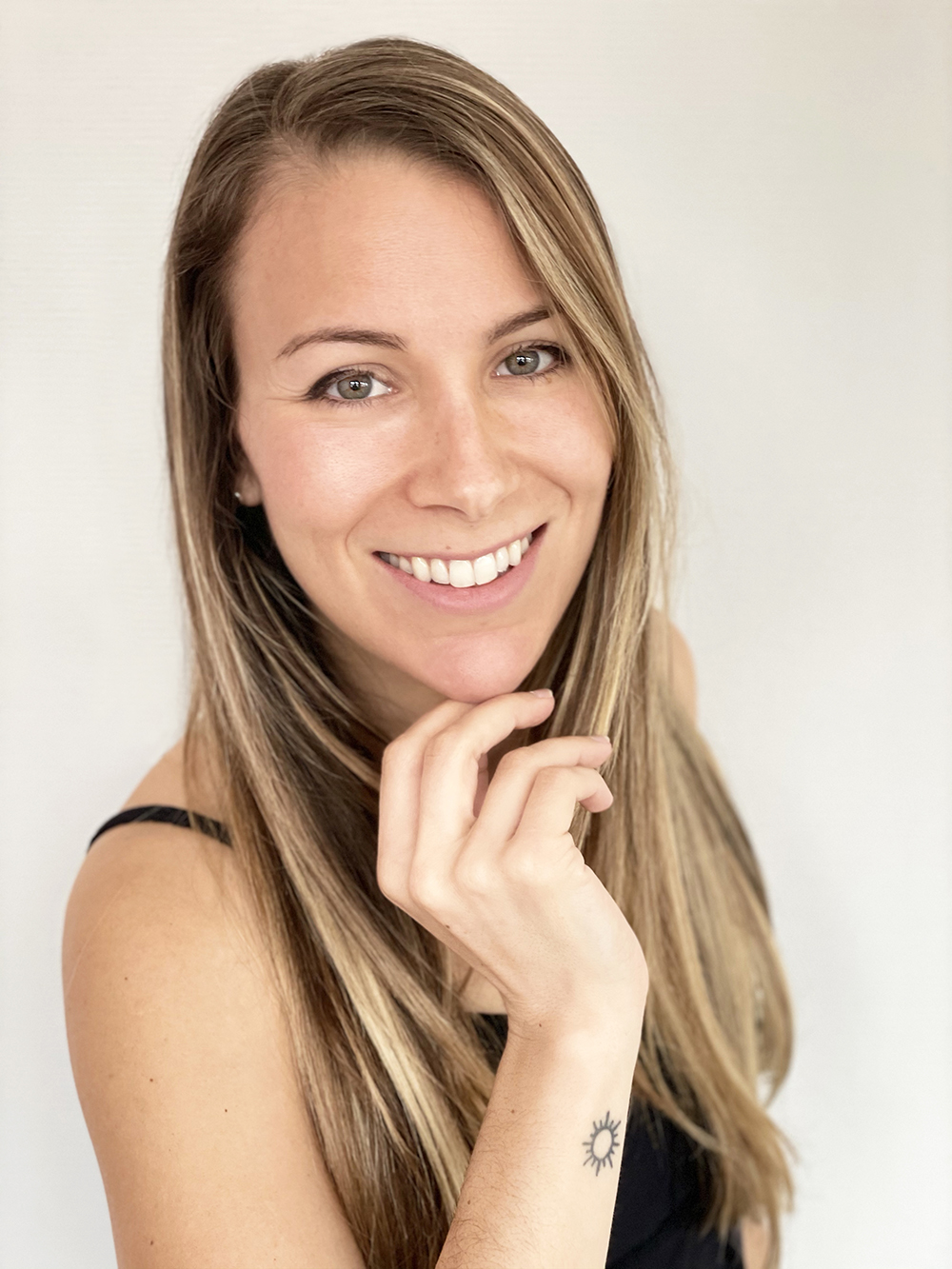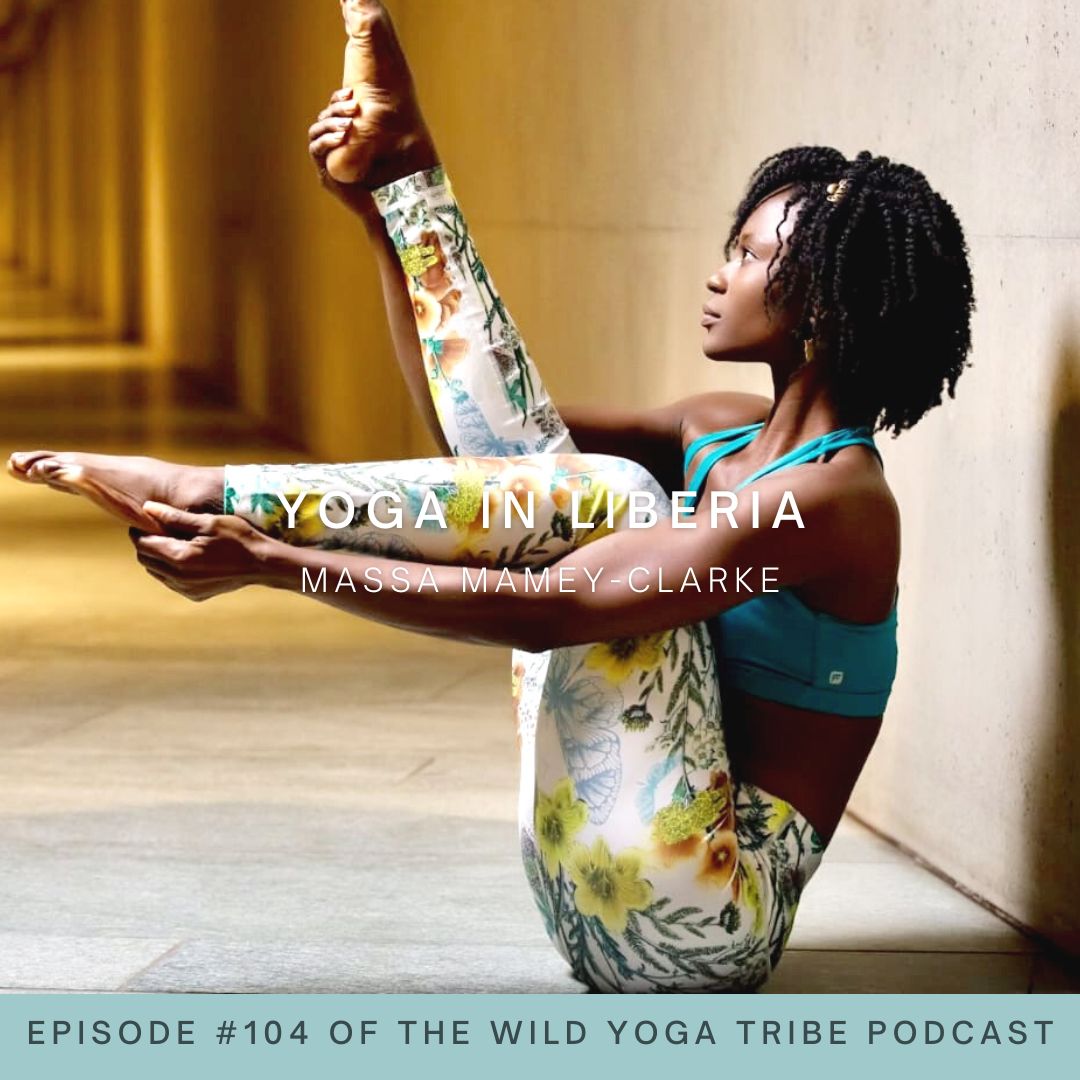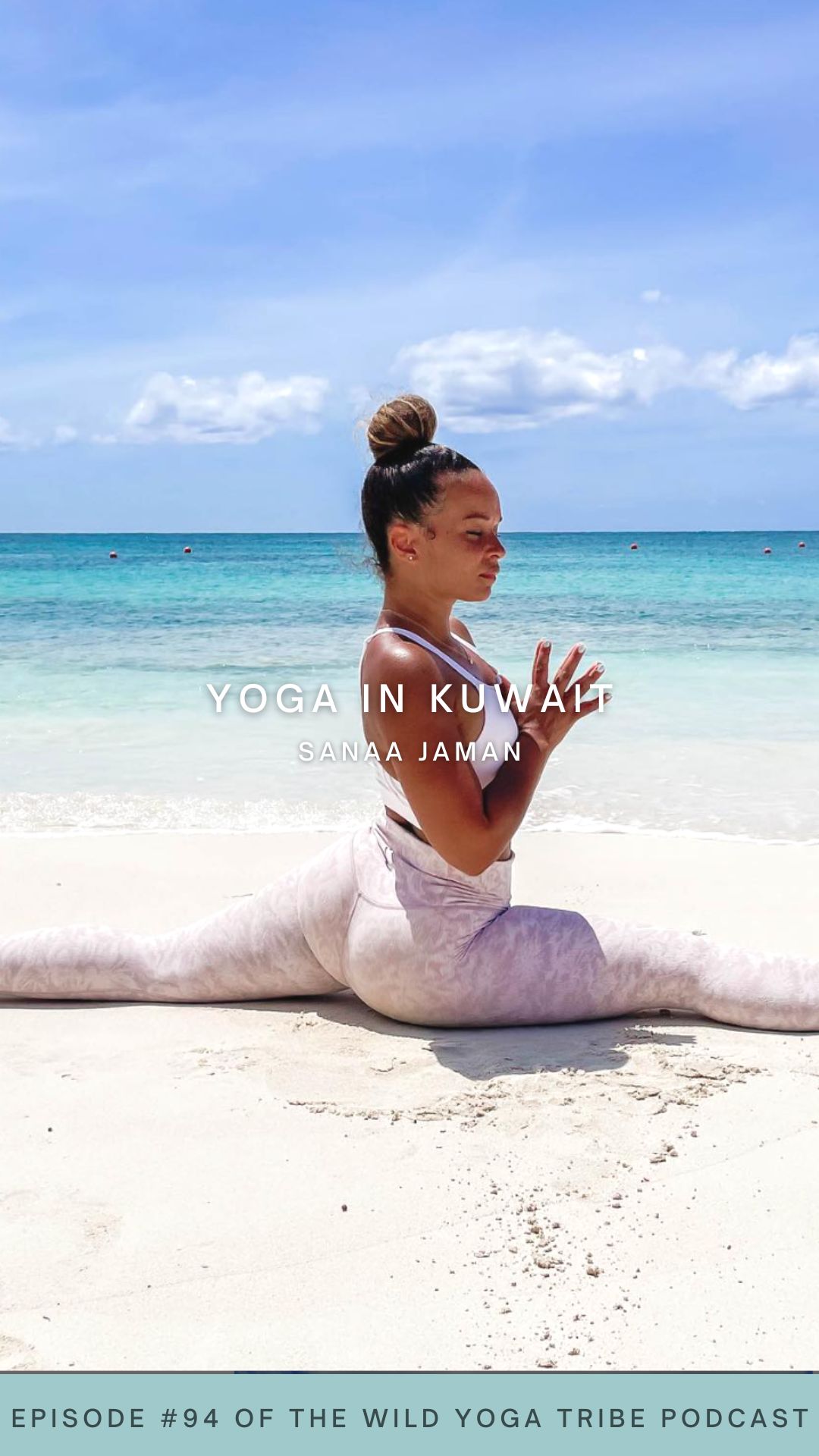
EPISODE #94 – YOGA IN KUWAIT
Meet Sanaa Jaman
Meet Sanaa Jaman, a yoga teacher from Kuwait who founded Tru Yoga, a unique studio emphasizing the mind, body, and soul connection. Let’s learn from Sanaa’s intentional and mindful approach, influenced by the concept of “Ikigai,” creates a transformative and nurturing experience for her students. Welcome to the world of yoga in Kuwait!
Wild Yoga Tribe Podcast Episode #94 – True Yoga – Yoga in Kuwait with Sanaa Jaman
Welcome to Episode #94 of the Wild Yoga Tribe Podcast! My conversation with Sanaa Jaman, a yoga teacher from Kuwait, was so beautiful as dove into the mind, body, soul connection, and the importance of not fixing people but seeing them and holding space for them to be. I hope that this conversation made you take a big and beautiful exhale, and to remember that your goals may be one thing but as life unfolds, you’ll end up where you need to be. If you’re looking to tune into a podcast episode that is all about yoga in Kuwait then this is the conversation for you.
Tell me more about Sanaa Jaman
Born and raised in Kuwait, Dr. Sanaa Jaman, owner of Tru3 Yoga studio, holds a Ph.D. in environmental engineering sciences and an executive master’s in business administration (EMBA). With her discovery of the therapeutic and healing virtue in the art of yoga, Dr. Jaman began a personal healing journey and continues to deepen her knowledge of yoga and its philosophy by hosting international retreats and training programs that help thousands around the globe.
What to expect in the Yoga In Kuwait episode of the Wild Yoga Tribe Podcast
Sanaa Jaman, the founder of Tru Yoga in Kuwait, shares her inspiring journey of creating a unique yoga studio that focuses on the mind, body, and soul connection. The studio’s name, “Tru Yoga,” serves as a reminder to their community about the importance of holistic well-being. Her journey into the yoga world and the establishment of her studio were serendipitous and driven by her desire to play, explore, and embrace opportunities that came her way. Every step of creating the studio was taken with love and intentionality, from the choice of paint color to the materials used, creating a mindful and nostalgic experience for visitors.
Sanaa also shares the concept of “Ikigai,” which influenced her goal of creating a simple, intentional, and mindful experience for her students. The tea room in her studio, inspired by Japanese culture, symbolizes community and seeking truth together.
Throughout the podcast, Sanaa gives insights into Kuwait’s culture, its slow-paced and community-oriented lifestyle, and how yoga is slowly starting to blossom in Kuwait as well.
When asked about her personal definition of yoga, Sanaa beautifully describes it as the awareness of self and connecting to oneself. Through this journey of self-discovery and acceptance, one can find inner peace and embrace all emotions and limitations.
Additionally, Sanaa’s experience hosting international retreats and training programs offers valuable insights for yoga practitioners interested in creating transformative and nurturing experiences for their participants.
This podcast episode provides a glimpse into the world of Tru Yoga and Sanaa Jaman’s passion for sharing the mind-body-soul connection with her community. Listeners are encouraged to explore yoga beyond the physical postures, seek truth, and find peace within themselves, just as Sanaa has done with her studio and her life’s path.
Favorite Quote From Sanaa Jaman
“A lot of times when people approach yoga, they want to find peace, when I think yoga is really about finding truth. And when you find the truth, you’re at peace with the truth. Whether you like the truth or not, you accept it and you’re at peace with it.”
What’s in the Yoga in Kuwait?
Feel like skimming?
The therapeutic and healing virtues of yoga
Don’t seek to fix people, see people and hold space for them
Three tips for hosting international yoga retreats
What was it like to open a yoga studio in Kuwait?
Yoga isn’t about finding peace, rather it’s about finding truth
Connect with Sanaa Jaman
https://www.instagram.com/ladydork/
https://www.instagram.com/tru3yoga/
Support the podcast:
https://www.patreon.com/wildyogatribe
Want more?
https://wildyogatribe.com/thepodcast/
Everything you need is just one click away! Check out all the resources here: https://linktr.ee/wildyogatribe
PODCAST TRANSCRIPTION
Read + Reflect + Respond
Wild Yoga Tribe Podcast Episode #94 – Yoga in Kuwait with Sanaa Jaman Podcast Transcription
[00:00:00] Lily Allen-Duenas: Namaste family and welcome back to the wild yoga tribe podcast. Today I am. so excited to welcome Sanaa Jaman onto the show today. She is a yoga teacher and studio owner from Kuwait. She’s the owner of Tru3 yoga studio, and she also holds a PhD in environmental engineering sciences, and an executive master’s in business administration.
So those are fascinating. Just to start off, she had this amazing discovery of the therapeutic and the healing aspects of yoga. She began her personal healing journey. In 2019, she opened her studio Tru3 yoga. Sanaa has taught yoga in twenty states and in over ten countries.
I’m so excited to dig more into her experience with nine years of teaching yoga, leading international retreats and her training programs that have helped thousands of people. Thank you so much for joining me on the show today.
[00:00:59] Sanaa Jaman: Thank you. I’m happy to be here. Thank you.
[00:01:02] Lily Allen-Duenas: So just to start us off, could you tell us more about your journey, how yoga first came into your life?
How did yoga come into your life?
[00:01:07] Sanaa Jaman: Yes I discovered yoga for the very first time actually in 2009 when I began my graduate studies in Florida. One of my colleagues took me to a hot yoga class and I actually did not like the class at all. Not one bit. I remember feeling isolated, feeling behind, I just didn’t know any of the movements. [00:01:30] It was just very intense and I didn’t feel like I was welcomed or assisted. I thought that was just yoga, that particular style was just all yoga.
So I stopped after that, I didn’t go to any classes and I got reintroduced to it again in 2013. I got introduced to it online and I started practicing at home and started teaching myself all these yoga postures. Although my journey didn’t necessarily begin as a healing journey, it led to there.
I was more focused on the postures because I had an athletic background, and I wanted to challenge my body. But throughout the journey of practicing and watching me build strength and mobility, I’ve noticed that during my studies and the stress of getting a PhD. I was a lot calmer.
Things were happening, but I was not responding to them in a very intensive or reactive way. That intrigued me. I related it to yoga, even though I wasn’t focused on breath work or meditation. It was happening from a normal physical practice. That’s where I became really intrigued about it and wanted to learn more about it.
How is it that if I’m not focused on breathwork, and meditation, that I’m able to become more centered, disciplined, grounded, and calm. So I enrolled in [00:03:00] yoga teacher training, which was caused by this engineering firm I was working at while getting my PhD. I started to learn more about philosophy and history, that made me want to dive even deeper into yoga.
My original approach wasn’t to teach, I wanted to learn for myself. Then a year or two after getting my certificate, I started to slowly teach. I taught friends and family first and then I started to expand a little bit. What made me really become, I would say, successful is my discovery of yoga was also the same time as social media started to pick up, especially Instagram.
My brand was mostly sharing authentically my practice, the challenges, the obstacles, like how to start. That made people want to join my classes, my workshops and eventually my retreats. So throughout my journey of yoga, It has always been something that I hold dear to my heart because it helped me through a lot of breakups. It helped me through a torn meniscus and just recently injured shoulder, a car accident. And so it has really transformed my life. I made it after graduating, getting my PhD [00:04:30] . I would want to take a risk, if you want to call it that. Leave the world of academia, engineering and dive into the world of yoga. See how I could share the message, and the medicine of yoga with my community.
[00:04:46] Lily Allen-Duenas: Very cool. Very cool. Now I love the message and the medicine of yoga. You said that beautifully, and hearing how you thought, you were going to learn yoga, and get your certification just for you. Then that slow development of wanting to teach and wanting to share.I am curious though, you have such amazing and impressive degrees.
Do you think your background in environmental engineering sciences has influenced your approach to yoga and its philosophy? Or either that or your other degree in executive masters in business administration has that impacted how you lead your studio?
Did your degrees influence your approach to yoga?
[00:05:23] Sanaa Jaman: Yeah, I got my masters just recently in business in February. So I actually got it after I opened my studio. But getting my PhD has helped me in the business of yoga. And so the reason I’m able to create training and curriculums for my studio is due to the skills that I’ve had from getting a PhD.
The writing, the research, all of that has helped me develop a lot of quality training that I have at True Yoga. I think the ethical part, because that’s in [00:06:00] me, regardless of my degrees. I consider myself to be an ethical person and that transfers and everything that I do. Whether that’s getting my PhD in environmental engineering, which I worked on water quality and then in yoga.
I bring that in as well. The masters I took because I wanted to have a bit more background about running the business a little bit better as far as operations. That’s why I did it. I did it at a time where things were slowing down during the pandemic. So I figured it would be the perfect opportunity since.
The business is slowing down so I could take this time to learn and how to benefit my business when things pick back up. So hopefully that makes sense.
[00:06:46] Lily Allen-Duenas: Yeah, that does. I think it’s amazing and yeah, ethical from the get go is always a great way to, to identify and feel and be. But then to have studied water quality, I know that probably doesn’t translate quite into yoga, and then also awesome and hilarious at the same time that you’ve got your master’s in business administration after opening the studio because maybe there was some of that reflection like, oh, I could have done that differently or maybe there was the high fives of Ooh, I did a good job. Maybe both. That’s really cool. I did want to ask you about: you mentioned the torn meniscus and a few things already.
So how did you first discover the therapeutic and healing aspects of yoga? So was [00:07:30] there a specific moment, maybe track back? I know you, we talked about it in the beginning of the podcast, but was there just that specific moment for you where you’re like oh, that is therapeutic. I know you mentioned when you’re studying and then noticing you were feeling more grounded. Is there something else you want to expand upon in that?
How did you first discover that therapeutic and healing aspects of yoga?
[00:07:49] Sanaa Jaman: What happened after I tore my meniscus is, I couldn’t work out anymore or train anymore. I had to do physical therapy, I needed something else to keep me active that wasn’t aggressive or had a huge impact on my joints. That’s why I was like, okay, let me try this yoga thing.
Literally, that was my approach. Let me try it. My idea, literally I had no knowledge of yoga, like zero. My idea of yoga was like, okay, people just sit in meditation and do breath work. That’s all I knew about yoga. When I knew there were postures, and some of the advanced postures specifically, the scorpion, everybody knows my story, like the scorpion is what sparked my interest.
Out of all the postures, I chose the most difficult one. When I saw it, something in me was like, one, confused at how a body can be inverted and bent that way. The stubborn side of me, where I’m like a go-getter when it comes to anything, where it’s like, Okay, I want to learn how to get to this posture.
I don’t care how long it [00:09:00] takes me, what I need to do. I need to do that. I don’t know why, but it was something that I was just determined to do. From there I started to bring awareness to my body and where it was at. I knew that I had strong legs, but my core and upper body weren’t that great.
That I joined boxing. I was like, okay, let me work, I know they do a lot of core. Let me join boxing. I started to really work on, learning the foundational postures of yoga and mastering them. Like I wouldn’t even practice the advanced postures. I would just do a forward fold, and the chaturanga.
Or anything that was like the most foundational and master them, and hold them for long periods of time. Fifteen to twenty breaths of real engagement. I started in January 2013. By that October I was able to do the scorpion and touch my head, and that to me, it just blew me.
Because I didn’t, I don’t have a background in dance or gymnastics. I never thought of myself as a mobile or flexible person. So to be able to see that my body was strong and bendy at the same time, it blew me away. I want to learn more and more from not only physical, but also the discipline it took me, like I was practicing nonstop to get me there.
So, I remember that [00:10:30] year until this day when I teach, I always teach my students from a beginner’s perspective and my perspective when I first started. And I tell them like, we’re not going to practice an advanced practice. My idea of advances, mastering the foundational postures. Postures this brings awareness to where you’re at and how you can improve without worrying about safety, like injuring yourself. That’s really like my philosophy when I’m teaching.
[00:10:59] Lily Allen-Duenas: That’s awesome. Sanaa, I also don’t come from a background of dance and I know some teachers definitely do. Wow, what a kind of a gift to come out of that and already have the proprioception, the awareness of your body in space and the mobility, the bendiness. Yes, it is a very humbling experience to come to the practice when you haven’t ever really bent or moved in those ways before. So about Sena, I really wanted to talk to you about all of your experiences hosting international retreats and your training programs. Can you tell us more about that? Your experience with that. What was it like? What advice would you give to other people? Because we have a lot of yoga teachers who listen to this podcast and not all of them do lead retreats. That’s something I hear back a lot is, I would love more advice on how to get started doing that. So could you walk us through it a bit?
Advice for yoga teachers who want to lead retreats
[00:11:55] Sanaa Jaman: Yeah, of course. I agree with you. A lot of people want to do retreats, but it [00:12:00] takes a lot of courage, surrender and steps to arrive at hosting a successful retreat. So to give background, everything I do when it comes to business, for me, always come. It’s from a place of intention, like the purpose, like, why am I doing this?
Who am I serving and what am I going to bring into the community? When I first launched my very first retreat, it was at a time I was actually going through a depression. I had just gone through a bad breakup. Just finished my PhD. I try to take this risk with yoga and teaching.
It’s not bringing me money. I had to live with my sister, sharing the same bed at 30 years old, when I had my own apartment, my own car. I gave up everything to try to dive into yoga without mentorship or guidance. I was just going off intuition and intention. I wanted to serve my community and I wanted to do this.
That’s all I knew. During that time, I had decided to go to Indonesia for a week. And don’t ask me why I decided I get intuitive. And for that week, I wanted to disconnect from the world. I turned my phone off. I traveled with just a carry on, which I’ve never done for a whole week. I just booked my flight and the Airbnb, I didn’t know what I was going to do.
Once I arrived there, I spent that week praying, meditating, and [00:13:30] basking in nature and the energy of that space. I came back home. I was on a natural high. I came out of my depression, literally. I was like, okay, life is great. It’s just amazing. Then more things happened over the summer.
I went back into it and I just remembered that feeling I had during that week. If I experienced that during that week, I’m pretty sure other people will too. That’s when my first retreat was born. It was literally, I sat there, I was like, okay, I’m going to replicate my experience.
How to nurture your audience and build your yoga community
[00:14:10] Sanaa Jaman: I’m going to have people come to this island that I found off the coast of Bali called Gili Air. They’re going to turn their phones off, they’re just going to come, and going to sit with themselves. And all I had, I remember, was a picture and a story, and I posted it, and within 48 hours it was sold out.
Now, some people think, oh, it just happened, you’re lucky. But what happened prior, and that’s 2017, is four years prior to 2017, is that I was running workshops nationwide in the United States. Every summer I did what I called my Dorp Tour. And so I would go from city to city, drive, and I would go to where I think my clientele would be, and I would connect with my community.
And I would lead a two hour workshop. And I did this every year. [00:15:00] I was not generating income from that. Everything I made was going into expenses. But what I was doing is building relationships. And so when it came time for me to market, and that was just not only in person, but also on social media, I built a trusting relationship with my audience.
And when it came time for me to announce my retreat, that relationship was already nurtured. So now people feel comfortable to go across the waters and meet me somewhere. My advice is always when people are interested in retreats, it’s the question, how have you been nurturing your audience up until this point. I always start with maybe you’re not like a digital person, you don’t have to do social media, it’s not for everybody, but within your community. If you’re having a hard time filling up your classes, a hard time leading workshops and masterclasses and people are not coming. You’re going to have a hard time getting people on a flight to go to a retreat.
People sometimes make this mistake. I need to find somewhere gorgeous and people will just come and that’s false because they can just go there on their own. What people want from a retreat is the intentionality in this healing space. That’s what they go for because they can do yoga anywhere.
And so as a yoga teacher, when you’re leading your group classes and you start to elevate yourself into [00:16:30] workshops and masterclasses, you start to ask yourself, what is the message that I’m trying to deliver? And as I used earlier, the word medicine, how am I helping my community become better on and off the mat? How am I, allowing them to, dive deeper into themselves?
You build that nurturing relationship with them. Then when it’s time for you to announce your retreat, they trust you enough to get on a flight and go somewhere with you. Because it does require trust. People work hard for their money and for their time as well.
For them to take time off and spend money to go somewhere with you, it takes a lot. So you have to build that trust. I think that’s the common mistake people make. They think I just need to pick a beautiful place, and post it on Instagram or post some flyers at the studio and people will register.
But without that nurturing relationship, people won’t come. Because it does take a lot for them to take that leap and take that step.
[00:17:32] Lily Allen-Duenas: Yeah, I hundred percent agree. I do love hearing your backstory saying how you led up to posting your retreat in Gili Air in Indonesia. Within two days of being sold out, like that is a magic moment, but also knowing all the hard work you put in on the backend before that moment to build the trust, to build the relationships, to nurture everything like that.I’ve also been to Gili Air in Indonesia. I spent a week or two there. It was a very beautiful, very amazing [00:18:00] spot.
[00:18:00] Sanaa Jaman: Yeah, it’s a magical place. Is there something in that? It feels like home. For me, it’s when I went there, it felt that way, and I wanted my community to feel that way. Where, you get to see the beautiful clear waters, the mountains, the rise of the moon, and the rise of the sun. I wanted people tocut off the noise of technology, and family and friends and just give themselves space to be with themselves. We’re not usually. We don’t usually give ourselves permission to just be with ourselves. We’re continuously occupying ourselves with multiple things, work, family obligations, partnerships, and we never really just stick with ourselves, and it takes even when we do the retreats, it takes about a day or two, maybe three days for people to get acclimated to that, because it’s just waiting.
I’m not doing anything. I’m like, no, we practice. We had our workshop. Now you have the rest of the day to figure things out. Go play. You have this island to go play. It takes a bit for their body and their mind to adjust to that. But once it does, they feel so free and it’s so beautiful to witness.
[00:19:07] Lily Allen-Duenas: Yes it is. So do you have a couple pieces of actionable advice, like three pieces of just heavy hitting advice that you’d give to someone who wants to lead a yoga retreat?
Three pieces of actionable advice for yoga teachers who want to lead yoga retreats
[00:19:17] Sanaa Jaman: Yes. The first advice is make sure you start to, again, build a nurturing relationship with your clientele. So if you’re teaching group classes, start to really deepen that relationship. That can be small conversations. Then move [00:19:30] up into leading workshops and masterclasses. This is where people really get to know a little bit more about you because it’s not just we’re flowing through postures They get you to know a little bit about your philosophy your principles your educational background So then you start to go a little bit deeper into the relationship with them And then you always want to take people on retreats to places that you personally have been And have a strong connection to as far as like healing.
I never run retreats in places I’ve never been or never felt like this is a healing space. I’ve traveled to a lot of countries around the world, certain countries I would never do a retreat at because it’s just the energy just didn’t feel like it was a retreat place. So make sure that you actually visit this place and physically go there and see if you can find a retreat center or a boutique hotel where you can host that place.
Spend a lot of time on really sharing the intention and the story as to why you want to host the retreat. What are people going to get out of this? It’s not about, again, doing just yoga in another country. The people like a theme. They like an intention. I would advise to, even as early As nine months to a year of announcing your retreat, I announced that early to allow people to set up a payment plan that is convenient for them and affordable so they can be able to do those monthly plans.
]I think a lot of people market just a [00:21:00] couple of months before the retreat. If you do it like nine months to a year, people can plan better. They can take their vacation time. They can do a payment plan that is affordable. They can figure out life. So that they can attend it. So that to me would be the biggest advice prior.
There’s advice also during, which is the main thing. Running a retreat, make sure that you hold that container for that whole week, that space, because it’s not just about, we’re just going to do a workshop and we’re just going to do a yoga session in the morning. But really making people feel seen, heard, and held.
That’s what I’ve learned over the years of running a retreat. People just want to be heard and seen. They don’t want anybody to fix their problems. Most of the time they just want people to hold the space and listen to them. It requires a lot of work, make sure that you have the energy and the capacity to hold space for 15 to 20 people for a whole week. Because that can also take a lot of work. So that would be my advice.
[00:22:03] Lily Allen-Duenas: Oh, powerful advice. I love that. That’s just to see people hold them and acknowledge not fix, right? Just to be with. I love that. Sanaa, I’d love to talk to you at this point also about your yoga studioTru3 and what was it like to open Tru3 in Kuwait?
What was it like to open a yoga studio in Kuwait
[00:22:22] Sanaa Jaman: So it’s called Tru yoga. The three is more like a logo thing. The three is basically a reminder for our community [00:22:30] that it’s about mind, body and soul connection, which is really important to me as we teach in the community. So yoga is slowly growing. Just give you back on slowly growing in Kuwait where one of the very few studios are in Kuwait and.
As yoga started to get westernized, it’s more asana based, more posture based, and people just focus on that. My goal is to remind the students and the teachers that we have to have the mind body soul connection. We do teach philosophy within the group classes. Just little small things that are not too heavy, but reminders that the practice continues off the mat.
My goal was never to teach yoga, but I ended up teaching it. My goal was never to open a yoga studio, but I ended up opening one. My goal was never to lead, everything I’m doing in the yoga space, as far as business, was not intentional. It wasn’t like, intentional in the sense of I’m going to do this X, Y, and Z. What my goal was, That I wanted to play in this space and I wanted to explore and most importantly, surrender. When the opportunities came that I was willing to surrender and take the step and take the leap. And so this opportunity of opening the studio came through a conversation.
I didn’t trust it. I was like, one person connects me to another person. This is how you could do it. This is how you can open a studio. This is how you can get funding. Like just one [00:24:00] conversation to another. I just took the leap and I continue to do this as I start to expand more and more in Tru yoga.
What is yoga in Kuwait like?
[00:24:07] Sanaa Jaman: Kuwait is growing. A little bit by a little bit, which is good, it’s good in a sense as if you thinking long term, this is good for you because you’re setting the foundation right now. But if you’re thinking like, Oh, I just need to make money now, it’s an uncomfortable space to be in.
But when you’re building quality, you understand that it takes time to bring that traction slowly. We’re getting there and people are recognizing us for our reputation and the quality that we put out. True yoga is literally my baby because I built it from the ground up. I literally tore down this previous space, which is four apartments.
I knocked them all down, opened the space, and then built it from the ground up. It was even built with love. People when they walk in the space, a lady shared with me today, she’s I’ve been to a lot of studios in Kuwait, but when I walk into your space, I feel the love. That makes me sometimes want to tear up.
It’s okay, the energy is still there. They feel it. the color to the paint, the brick, every single thing that is put in this space was with love and intention.
Ikigai and intentionality in yoga studios
[00:25:14] Lily Allen-Duenas: That’s amazing. I love hearing that people respond to that and feel that and that was your intention going in and obviously it carried through so beautifully. I know one of the things in your studio I read on your website, you’ve incorporated the concept of, is it [00:25:30] Ikigai, the Japanese, is it, did I pronounce it correctly?
[00:25:33] Sanaa Jaman: I’m not really sure. Don’t quote me on that.
[00:25:36] Lily Allen-Duenas: Okay. do you?
[00:25:37] Sanaa Jaman: Don’t speak Japanese, but yes.
[00:25:40] Lily Allen-Duenas: yeah, do you want to share with our listeners about the intentionality around that concept?
[00:25:44] Sanaa Jaman: Yeah. So for us, really, when I connected with that, what to me it means is just that I wanted to create an experience. In a very simple way, like a very simple way. To me, I’m always fascinated by Japanese culture aesthetic wise, but also intentionality. So going back to like intention, like when I’m looking at their cultures, the way they dress, the way they eat, the way they build things, the way they put energy into anything they do is very intentional, but it’s also not noisy.
It’s not really about being loud and using a minimal type of palette and, and slow living as well. And that’s what it really means. It’s really being mindful. And so for me, I was really intrigued by the similarities of how I like to live my life.
The culture, the Japanese culture and what I wanted. Also people feel like when they’re entering the space again, it’s not just about practice, but it’s also about the energy and the experience. Even when we created the tea room. It’s even it’s you have to sit on the floor, so influenced by Japanese culture, you sit on the floor, a low table with cushions, [00:27:00] and the whole purpose of that is to have, a community, and for people to figure out their reason for being here.
Here meaning, on earth, like what are we here to learn and how can we learn from each other as well? How can we share this over a cup of tea? Which is also similar to the culture in Kuwait, too. We like to drink tea a lot. And this whole idea of seeking truth. How do we seek truth? So the concept of aesthetics as far as materials that were used was minimal.
But there’s also texture as well. Aesthetic where it’s just and then nostalgic a little bit. There were, we have these glass bricks that I purposely put them there not only to create like this openness and so the room didn’t feel closed off, but we used to have these bricks growing up like in my grandmother’s house and any old houses that you grew up with, you saw those.
When people walk into the studio and they see them, they have this nostalgic feeling like, Oh my God, I remember this at my grandmother’s house. And they just instantly get excited. And so yeah, I think the Japanese concept of that is for me, it’s like minimal, but intentional and to figure out the reason for being here and seeking truth.
[00:28:13] Lily Allen-Duenas: I love that. I love that. So you have shared with us too about Yoga in Kuwait, how it’s just starting to grow, but I would love for our listeners who aren’t too familiar with Kuwait as a country as a whole. Could you share with us more about Kuwait?
What is Kuwait like?
[00:28:27] Sanaa Jaman: Yes, I will. So Kuwait, [00:28:30] it’s in the Middle East, if you don’t know where it is. People are familiar with the UAE or Dubai. So we’re like sister countries. We share similar culture and traditional backgrounds. And so the climate is really hot. It’s a desert.
It’s Arizona hot. But it gets really cold in the winter. Very conservative. We’re known to really be amazing in cuisines. And it doesn’t matter what cuisine, it could be Kuwaiti, Japanese, whatever. We’re like, food is like number one. I’m not saying that because Kuwait is just they just love the flavor here and then shopping.
That’s like their biggest thing, but also it’s very slow paced, which I like very intentional, and very creative. We have a lot of youth that are like always coming up with creative ideas as far as businesses and starting small businesses. It’s for me, I like it because it’s just very family oriented and community oriented.
Like people really genuinely care about you, whether they know you or not, and they take care of you. And that’s the feeling that I love about being home and, and even being in the studio.
[00:29:38] Lily Allen-Duenas: Awesome. Sanaa, a question I do ask for every yoga teacher who’s a guest on the show is, what is your personal definition of yoga?
What is your definition of yoga?
[00:29:47] Sanaa Jaman: I like that question. My personal definition is awareness of self and connecting to self. And when you have the awareness. And the connection to self, then you’re able to connect to everything [00:30:00] around you as well, including, if you believe in God or higher power, in order for you to connect to that, you have to first connect to yourself.
That can mean, mind, body and spirit connection. You have to have that awareness and that connection in order for you to really find your truth. And I think a lot of times when people approach yoga, they want to find peace, when I think yoga is really about finding truth.
And when you find the truth, you’re at peace with the truth. Whether you like the truth or not, you accept it and you’re at peace with it. It’s not that nothing is happening in your life that, you’re not bothered or you don’t get angry, you don’t feel emotions. No, it’s that you recognize those emotions, you hold space for them, but you accept them.
And so yoga allows you to arrive in that space where you get to know yourself and in all your emotions, all your thoughts, and all your body limitations, but you accept them and, you arrive at peace, being in peace with those limitations that you have and being okay with that.
[00:31:02] Lily Allen-Duenas: Ooh, lovely. I love that about yoga. It’s not about finding peace, but about finding truth. That’s powerful, Sana. A beautiful way to wrap up our time together. I have loved speaking with you. You have offered so many beautiful points of perspective and these little nuggets of grace, I think for our listeners, hopefully to really tap into and hopefully will resonate with them. So thank you for being with me today. It’s been such a [00:31:30] joy.
[00:31:31] Sanaa Jaman: Thank you. Thank you for having me. It’s been great talking to you and sharing my passion and sharing bits of my home and my journey with you and your listeners. Hopefully they learned a few things that could help them on their journey and continue to share, like I said, the medicine of yoga with their community. So thank you for having me.
Wild Yoga Tribe Podcast Outro
[00:31:49] Lily Allen-Duenas: Thank you so much for tuning in to this episode of the Wild Yoga Tribe podcast. My conversation with Sanaa Jaman, a yoga teacher from Kuwait and a yoga studio owner, was so beautiful as we dive into the mind, body, soul connection and the importance of not fixing people, but seeing them and holding space for them to just be.
I hope that this conversation made you take a big and beautiful exhale and to remember that your goals may be one thing, but as life unfolds, you’ll end up exactly where you need to be. If you’re looking to tune into a podcast episode, that’s all about yoga in Kuwait, then this is the conversation for you.
Copyright © 2023 Wild Yoga Tribe LLC. All rights reserved. Transcripts are generated using a combination of speech recognition software and human transcribers, and may contain errors. Kindly check the corresponding audio before quoting in print to ensure accuracy.
The Wild Yoga Tribe, LLC, owns the copyright in and to all content in and transcripts of the Wild Yoga Tribe podcasts, with all rights reserved, including right of publicity.
What’s Okay
You are welcome to share an excerpt from the episode transcript (up to 500 words but not more) in media articles (e.g., The New York Times), in a non-commercial article or blog post (e.g., Elephant Journal), and/or on a personal social media account for non-commercial purposes, provided that you include proper attribution and link back to the podcast URL. For complete transparency and clarity, media outlets with advertising models are also welcome to use excerpts from the transcript per the above.
What’s Not Okay
No one is authorized to copy any portion of the podcast content or use Lily Allen-Duenas’ name, image or likeness for any commercial purpose or use, including without limitation inclusion in any books, e-books, or on a commercial website or social media site (e.g., Instagram, Facebook, etc.) that offers or promotes your or another’s products or services. Of course, media outlets are permitted to use photos of Lily Allen-Duenas from her Media Kit page or can make written requests via email to receive her headshots folder.
